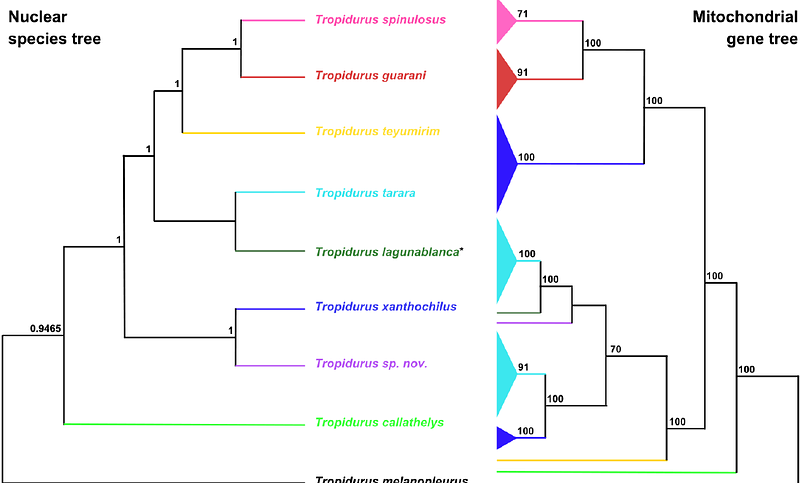Demographic history explains mitochondrial genome capture and mitonuclear discordance among South American collared Tropidurus lizards

Demographic history explains mitochondrial genome capture and mitonuclear discordance among South American collared Tropidurus lizards
Salles, M. M. A.; Carvalho, A. L. G.; Leache, A. D.; Martinez, N.; Bauer, F.; Motte, M.; Espinola, V.; Rodrigues, M. T.; Piantoni, C.; Pie, M. R.; Olivotto, A.; Colli, G. R.; Choueri, E. L.; Werneck, F. P.; Domingos, F. M. C. B.
AbstractMitonuclear discordance-evolutionary discrepancies between mitochondrial and nuclear DNA phylogenies-can arise from various factors, including introgression, incomplete lineage sorting, recent or ancient demographic fluctuations, sex-biased dispersal asymmetries, among others. Understanding this phenomenon is crucial for accurately reconstructing evolutionary histories, as failing to account for discordance can lead to misinterpretations of species boundaries, phylogenetic relationships, and historical biogeographic patterns. In this study, we investigate the evolutionary drivers of mitonuclear discordance in the Tropidurus spinulosus species group, which contains nine species of lizards inhabiting open tropical and subtropical environments in South America. Using a combination of population genetic and phylogenomic approaches, applied to mitochondrial and nuclear data, we identified different instances of gene flow that occurred in ancestral lineages of extant species. Our results point to a complex evolutionary history marked by prolonged isolation between species, demographic fluctuations, and potential episodes of secondary contact with genetic admixture. These conditions likely facilitated mitochondrial genome capture while diluting signals of nuclear introgression. Furthermore, we found no strong evidence supporting incomplete lineage sorting or natural selection as primary drivers of the observed mitonuclear discordance. Therefore, the unveiled patterns are most consistent with neutral demographic processes, coupled with ancient mitochondrial introgression, as the main factors underlying the mismatch between nuclear and mitochondrial phylogenies in this system. Future research could further explore the role of other demographic processes, such as asymmetric sex-biased dispersal, in shaping these complex evolutionary patterns.